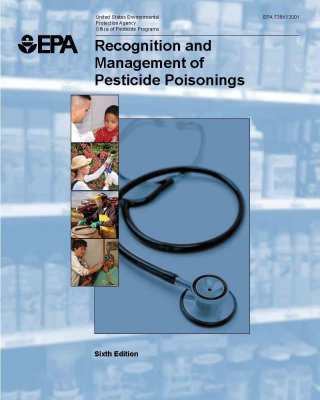Recognition and Management of Pesticide Poisonings

The Recognition and Management of Pesticide Poisonings: 6th Edition manual gives healthcare providers a quick reference resource for the best toxicology and treatment information for patients with pesticide exposures.
This manual also guides clinicians on how to:
- Conduct environmental and occupational exposure screening on patients
- Report of exposure incidents
- Find a wealth of available pesticide information resources
This manual was developed under a cooperative agreement between the EPA and the Medical University of South Carolina, and as such, reflects the views of the authors and not the EPA.
The Spanish version of the Recognition and Management of Pesticide Poisonings: 6th Edition is available online.
Recognition and Management of Pesticide Poisonings: 6th edition (full document)
Table of Contents
View a PDF version of the Table of Contents
Section I - General Information
- Chapter 1. Introduction
- Chapter 2. Making the Diagnosis
- Chapter 3. General Principles
Section II - Insecticides
- Chapter 4. Pyrethrins and Pyrethroids
- Chapter 5. Organophosphate Insecticides
- Chapter 6. N-Methyl Carbamate Insecticides
- Chapter 7. Organochlorines
- Chapter 8. Biologicals and Insecticides of Biological Origin
- Chapter 9. Other Insecticides and Acaricides
Section III - Herbicides
- Chapter 10. Chlorophenoxy Herbicides
- Chapter 11. Pentachlorophenol and Dinitrophenolic Pesticides
- Chapter 12. Paraquat and Diquat
- Chapter 13. Other Herbicides
Section IV. Other Pesticides
- Chapter 14. Insect Repellents
- Chapter 15. Arsenical Pesticides
- Chapter 16. Fungicides
- Chapter 17. Fumigants
- Chapter 18. Rodenticides
- Chapter 19. Miscellaneous Pesticides, Synergists, Solvents and Adjuvants
- Chapter 20. Disinfectants
Section V. Chronic Effects
- Chapter 21. Chronic Effects | (EPA Q&A)
Section VI. Appendices
- Appendix A: Detailed Occupational/Environmental Exposure History
- Appendix B: Key Competencies for Clinicians
Section VII. Indexes
About this Publication
- The 6th edition of Recognition and Management of Pesticide Poisonings was developed under Cooperative Agreement No. X8-83384201, awarded by the U.S. Environmental Protection Agency (EPA) to the Medical University of South Carolina.
- The updated manual is authored by James R. Roberts, M.D., M.P.H, and J. Routt Reigart, M.D., of the Medical University of South Carolina.
- The design and printing of this manual was facilitated by the National Association of State Departments of Agriculture Research Foundation (NASDARF) under the NASDARF Cooperative Agreement with EPA, No. X8-83456201.
